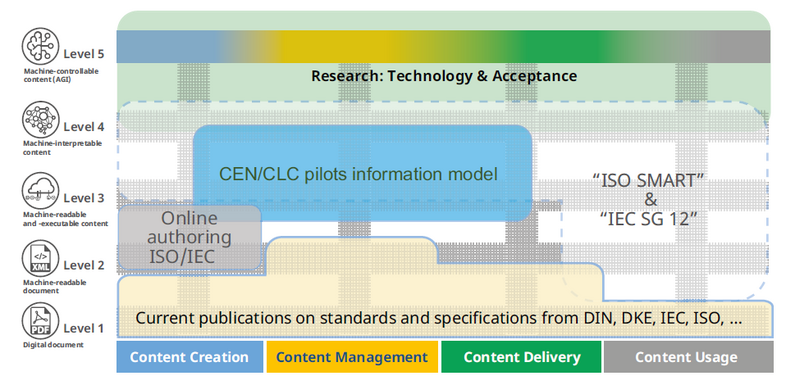KANBrief 1/22
To support the digital transformation, the German Institute for Standardization (DIN) and the German Commission for Electrical, Electronic and Information Technologies (DKE) have launched the national Initiative Digitale Standards (IDiS).
Paper has now largely disappeared from standardization. Page-based PDF files and monolithic documents in natural language must also be replaced progressively by solutions consisting of granular information units that can be automated. In order for more and more requirements to be met in less and less time, four value-adding process steps in standardization activity must be automated further:
In its white paper, Scenarios for digitizing standardization and standards, the Digital Standards Initiative (IDiS) has outlined how the transition can be completed in phases: by means of SMART Standards, i.e. standards with content applicable to machines, readable and transferable.
The activities are based on the SMART Standards Utility Model, which defines milestones and readiness levels of digitization in successive phases:
| Level 0 | Not machine-processable (e.g. paper) |
| Level 1 | Machine-visualizable digital document (Word, PDF) |
| Level 2 | Machine-readable document. Content and structure are separated (XML), enabling the structure and certain fragmented content to be extracted by a machine |
| Level 3 | Machine-readable and executable content. Granular information units are uniquely identified, their reciprocal relationships are recorded, and they are available for further processing and in some cases automated execution |
| Level 4 | Machine-interpretable content. The information modules are augmented such that they can be executed directly by a machine and complex processes can be automated |
The white paper also contains a perspective on the visionary Level 5, which addresses the growing influence of machine learning.
IDiS is currently divided into three working groups. Working Group 1 pursues a common understanding of the vision of the SMART Standards. Working Group 2 specifies initial pilot projects to demonstrate the benefits of SMART standards, gather experience and develop further fields of application. Working Group 3 reflects the (international) activities on the topic and coordinates external and internal activities. It is the first point of contact for national experts involved at international level.
The formula project addresses the demand for formulae found in standards. The formulae are to be delivered in various standard formats based on the XML-encoded content, enabling them to be evaluated, visualized or computed automatically. Such scenarios also benefit occupational safety, since relevant requirements are often expressed in formulae. One conceivable example is for the required minimum distance from electro-sensitive protective equipment to be calculated automatically by means of a formula set out in EN ISO 138551, or the maximum contact temperature to EN ISO 13732-12 to be calculated for prevention of skin burns in the event of contact with various hot materials and surface types.
Conformity testing in product development: formulae and table values are automatically transferred from a standard to the processing software through an interface (Level 3 content usage). This enables conformity testing by simulation to be used in the initial development phase of an electric motor to determine its efficiency. In the second development phase, it enables automated instrumented conformity testing to be performed for comparison purposes.
The benefit for manufacturers and operators is that product development becomes cheaper and faster, and instrumented conformity testing more efficient, since instantaneous values are transferred directly from the digital standard to the measuring instrument.
We can anticipate that the phases described will be detailed further and partly implemented in the coming years. ISO and IEC are for example currently developing a structure and harmonized IT specifications for the online authoring of content. These specifications are to enable content segments from different suppliers to be integrated directly into the digital standard. Further projects and possible developments:

Within IDiS, contributors are cooperating by trialling, shaping, providing information and pooling their experiences. At the same time, numerous other standards organizations around the world are working on the topic of “digital standards” – in some cases in isolation. Coordinated cooperation at European and international level is therefore urgently needed. IDiS presents an opportunity to assert national interests in European and international standardization work, since DIN and DKE are actively involved in international projects in this area at CEN, CENELEC, IEC and ISO. DIN and DKE invite interested parties to participate at no cost in IDiS, the national platform for SMART standards.
Raymond Puppan (DKE)
Andreas Wernicke (DIN)
1 EN ISO 13855, Safety of machinery – Positioning of safeguards with respect to the approach speeds of parts of the human body
2 EN ISO 13832-1, Ergonomics of the thermal environment – Methods for the assessment of human responses to contact with surfaces – Part 1: Hot surfaces